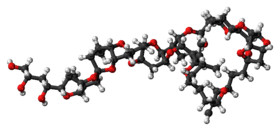Halichondrin B
 | |
 | |
| Names | |
|---|---|
| IUPAC name
(1S,2S,2′S,3S,3aS,3a′S,5R,6S,7S,7′S,7aS,7a′S,9S,12S,14R,16R,18S,20S,22R,26R,28S,29S,30R,34R,37S,39R,40S,41R,43R,44S)-7,7′,14′′,29′′-tetramethyl-8′′,15′′-dimethylidene-2-(1,3,4-trihydroxybutyl)decahydro-3′H,32′′H-dispiro[furo[3,2-b]pyran-5,5′-furo[3,2-b]pyran-2′,24′′-[2,19,23,27,31,38,42,45,47,48,49]undecaoxaundecacyclo[32.9.2.1~3,40~.1~3,41~.1~6,9~.1~12,16
~.0~18,30~.0~20,28~.0~22,26~.0~37,44~.0~39,43~]nonatetracontan]-32′′-one | |
| Identifiers | |
| 103614-76-2 | |
| 3D model (Jmol) | Interactive image |
| ChemSpider | 10256208 |
| UNII | 269R6PFM59 |
| |
| |
| Properties | |
| C60H86O19 | |
| Molar mass | 1,111.33 g·mol−1 |
| Except where otherwise noted, data are given for materials in their standard state (at 25 °C [77 °F], 100 kPa). | |
| | |
| Infobox references | |
Halichondrin B is a large naturally occurring polyether macrolide originally isolated from the marine sponge Halichondria okadai by Hirata and Uemura in 1986.[1] In the same report, these authors also reported the exquisite anticancer activity of halichondrin B against murine cancer cells both in culture and in in vivo studies. Halichondrin B was highly prioritized for development as a novel anticancer therapeutic by the United States National Cancer Institute[2] and, in 1991, was the original test case for identification of mechanism of action (in this case, tubulin-targeted mitotic inhibitor) by NCI's then-brand-new "60-cell line screen"[3][4] The complete chemical synthesis of halichondrin B was achieved by Yoshito Kishi and colleagues at Harvard University in 1992,[5] an achievement that ultimately enabled the discovery and development of the structurally simplified and pharmaceutically optimized analog eribulin (E7389, ER-086526, NSC-707389).[6][7] Eribulin was approved by the U.S. Food and Drug Administration on November 15, 2010, to treat patients with metastatic breast cancer who have received at least two prior chemotherapy regimens for late-stage disease, including both anthracycline- and taxane-based chemotherapies.[8] Eribulin is marketed by Eisai Co. under the tradename Halaven.
References
- ↑ Hirata Y, Uemura D (1986). "Halichondrins - antitumor polyether macrolides from a marine sponge". Pure Appl. Chem. 58 (5): 701–710. doi:10.1351/pac198658050701.
- ↑ "Success Story: Halichondrin B (NSC 609395) E7389 (NSC 707389)". Developmental Therapeutics Program, National Cancer Institute.
- ↑ "NCI-60 DTP Human Tumor Cell Line Screen". Developmental Therapeutics Program, National Cancer Institute.
- ↑ Bai RL, Paull KD, Herald CL, Malspeis L, Pettit GR, Hamel E (August 1991). "Halichondrin B and homohalichondrin B, marine natural products binding in the vinca domain of tubulin. Discovery of tubulin-based mechanism of action by analysis of differential cytotoxicity data". J. Biol. Chem. 266 (24): 15882–9. PMID 1874739.
- ↑ Aicher TD, Buszek KR, Fang FG, Forsyth CJ, Jung SH, Kishi Y, Matelich MC, Scola PM, Spero DM, Yoon SK (1992). "Total synthesis of halichondrin B and norhalichondrin B". J. Am. Chem. Soc. 114 (8): 3162–3164. doi:10.1021/ja00034a086.
- ↑ Towle MJ, Salvato KA, Budrow J, Wels BF, Kuznetsov G, Aalfs KK, Welsh S, Zheng W, Seletsk BM, Palme MH, Habgood GJ, Singer LA, Dipietro LV, Wang Y, Chen JJ, Quincy DA, Davis A, Yoshimatsu K, Kishi Y, Yu MJ, Littlefield BA (February 2001). "In vitro and in vivo anticancer activities of synthetic macrocyclic ketone analogues of halichondrin B". Cancer Res. 61 (3): 1013–21. PMID 11221827.
- ↑ Yu MJ, Kishi Y, Littlefield BA (2005). "Discovery of E7389, a fully synthetic macrocyclic ketone analogue of halichondrin B". In Newman DJ, Kingston DGI, Cragg GM. Anticancer agents from natural products. Washington, DC: Taylor & Francis. ISBN 0-8493-1863-7.
- ↑ "FDA approves new treatment option for late-stage breast cancer" (Press release). USFDA. 2010-11-15. Retrieved November 15, 2010.